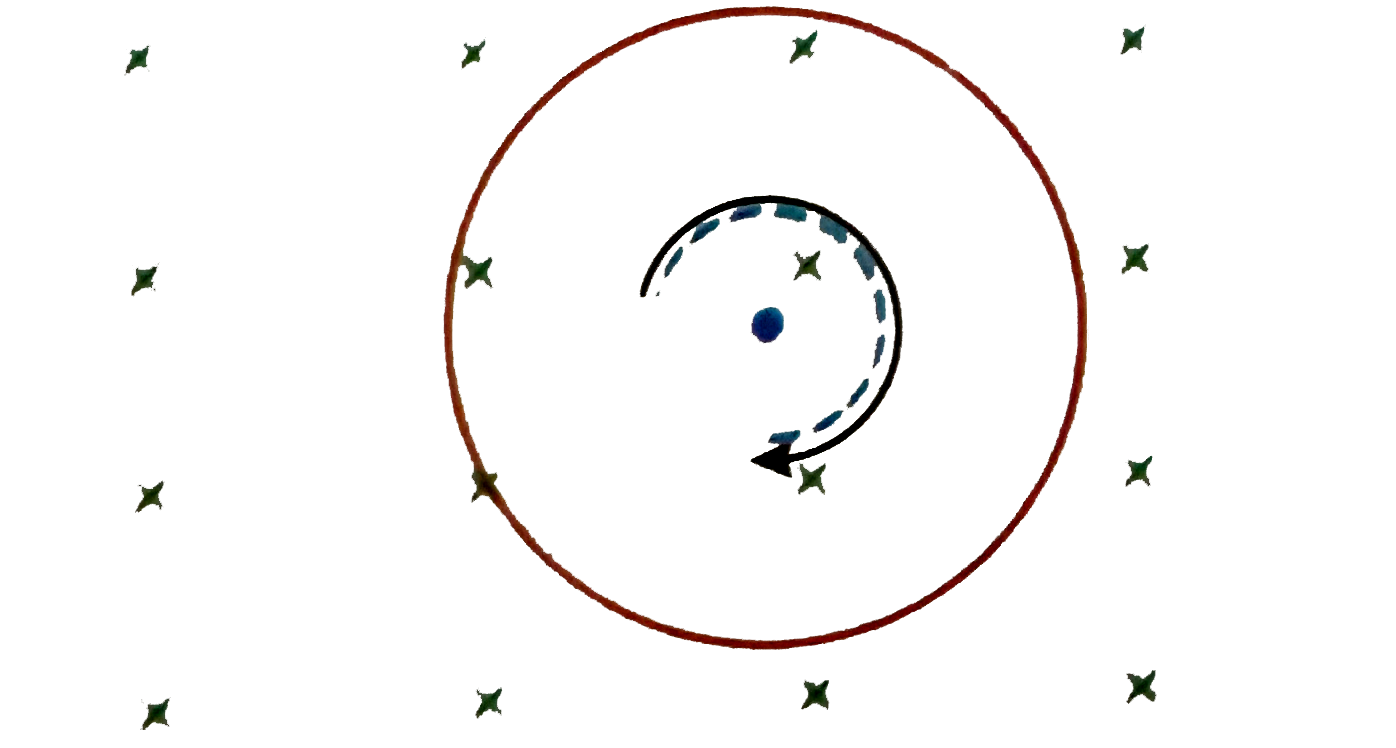A circular copper disc of radius 25 cm is rotating about its own axis with a constant angular velocity of 130rad/s . If a magnetic field of 5×10−3 Tesla is applied at right angles to the disc, then the induced potential difference between the centre and the rim of the disc will approximately be __
20×10−3V
20×10−6V
20×10−9
Zero
The correct Answer is:a
To solve the problem of finding the induced potential difference between the center and the rim of a rotating copper disc in a magnetic field, we can follow these steps:
Step 1: Identify the given values
- Radius of the disc, R=25cm=0.25m
- Angular velocity, ω=130rad/s
- Magnetic field strength, B=5×10−3T
Step 2: Understand the induced EMF in a rotating disc
The induced EMF (dE) in a small element of the disc can be calculated using the formula:
dE=B⋅v⋅dL
where:
- v is the linear velocity of the small element,
- dL is the length of the small element.
Step 3: Calculate the linear velocity
The linear velocity v of a point at a distance x from the center of the disc is given by:
v=ω⋅x
Step 4: Set up the expression for induced EMF
Taking a small strip of thickness dx at a distance x from the center, the induced EMF can be expressed as:
dE=B⋅(ω⋅x)⋅dx
Step 5: Integrate to find total EMF
To find the total EMF (E) between the center (0) and the rim (R), we integrate:
E=∫R0B⋅(ω⋅x)dx
This simplifies to:
E=B⋅ω∫R0xdx
Step 6: Solve the integral
The integral ∫R0xdx evaluates to:
∫R0xdx=(x22)R0=R22
Thus, we have:
E=B⋅ω⋅R22
Step 7: Substitute the known values
Now substituting the values:
E=(5×10−3T)⋅(130rad/s)⋅(0.25m)22
Calculating (0.25)2=0.0625:
E=(5×10−3)⋅(130)⋅0.06252
E=(5×10−3)⋅(130)⋅(0.03125)
E=5×130×0.03125×10−3
E=20.3125×10−3V
Step 8: Round the result
Thus, the induced potential difference is approximately:
E≈20×10−3V=20mV
Final Answer
The induced potential difference between the center and the rim of the disc is approximately 20mV.
---
- Radius of the disc, R=25cm=0.25m
- Angular velocity, ω=130rad/s
- Magnetic field strength, B=5×10−3T
The induced EMF (dE) in a small element of the disc can be calculated using the formula:
dE=B⋅v⋅dL
where:
- v is the linear velocity of the small element,
- dL is the length of the small element.
The linear velocity v of a point at a distance x from the center of the disc is given by:
v=ω⋅x
Taking a small strip of thickness dx at a distance x from the center, the induced EMF can be expressed as:
dE=B⋅(ω⋅x)⋅dx
To find the total EMF (E) between the center (0) and the rim (R), we integrate:
E=∫R0B⋅(ω⋅x)dx
This simplifies to:
E=B⋅ω∫R0xdx
The integral ∫R0xdx evaluates to:
∫R0xdx=(x22)R0=R22
Thus, we have:
E=B⋅ω⋅R22
Now substituting the values:
E=(5×10−3T)⋅(130rad/s)⋅(0.25m)22
Calculating (0.25)2=0.0625:
E=(5×10−3)⋅(130)⋅0.06252
E=(5×10−3)⋅(130)⋅(0.03125)
E=5×130×0.03125×10−3
E=20.3125×10−3V
Thus, the induced potential difference is approximately:
E≈20×10−3V=20mV
The induced potential difference between the center and the rim of the disc is approximately 20mV.
Topper's Solved these Questions
- ELECTRO MAGNETIC INDUCTIONBook:MOTIONChapter:ELECTRO MAGNETIC INDUCTIONExercise:EXERCISE-2 (Objective problems (Analytical questions))
Explore 70 Videos
- ELECTRO MAGNETIC INDUCTIONBook:MOTIONChapter:ELECTRO MAGNETIC INDUCTIONExercise:EXERCISE-3 (Assertion & Reasoning)
Explore 18 Videos
- ELECTRO MAGNETIC INDUCTIONBook:MOTIONChapter:ELECTRO MAGNETIC INDUCTIONExercise:QUESTION FOR PRACTICE
Explore 41 Videos
- Electrical Instrument Book:MOTIONChapter:Electrical Instrument Exercise:EXERCISE -3
Explore 16 Videos
- ELECTRO MAGNETIC WAVES Book:MOTIONChapter:ELECTRO MAGNETIC WAVES Exercise:EXERCISE - 3 (SECTION - B)
Explore 8 Videos
Similar Questions
A copper disc of radius 1m is rotated about its natural axis with an angular velocity 2rad/sec in a uniform magnetic field 5 telsa with its plane perpendicular to the field. Find the emf induced between the centre of the disc and its rim.
View SolutionA conducting disc of radius r rotates with a small but constant angular velocity ω about its axis. A uniform magnetic field B exists parallel to the axis of rotation. Find the motional emf between the centre and the periphery of the disc.
View Solution
Knowledge Check
When a circular disc of radius 0.5 m is rotating about its own axis, then the direction of its angular momentum is
Aalong the tangent drawn at every pointBradialCperpendicular to the direction of angular velocityDalong the axis of rotation of the bodyA disc of mass 1 kg and radius 10 cm is rotating about its axis with an anuglar velocity of 2 rad/s. The linear momentum of the disc,
A0.2 kg-m/sBzeroC0.4 kg-m/sD0.02 kg-m/sA homogeneous disc of mass 2 kg and radius 15 cm is rotating about its axis with an angular velocity of 4 rad/s. the linear momentum of the disc is
A1.2 kg m/sB1.0 kg m/sC0.6 kg m/sDzero
A circular copper disc of 10 cm radius rotates at 20π radian/sec about an axis through its centre and perdendicular to the disc. A uniform magnetic field of 0.2 T acts perpendicular to the disc. Calculate the potential difference developed between axis of the disc and the rim. What is the induced current if resistance of disc is 2 ohm ?
View SolutionA circular disc is rotating about its own axis, the direction of its angular momentum is
View SolutionA circular disc of mass 4kg and of radius 10cm is rotating about its natural axis at the rate of 5rad/sec. Its angular momentum is
View SolutionA uniform circular disc of radius R is rotating about its own axis with moment of inertia I at an angular velocity ω if a denser particle of mass m is gently attached to the rim of disc than its angular velocity is
View SolutionA non-conducting disk of radius R is rotating about its own axis with constant angular velocity ω in a perpendicular uniform magnetic field B as shown in figure. The emf induced between centre and rim of disk is

View Solution

